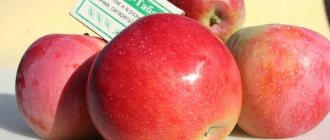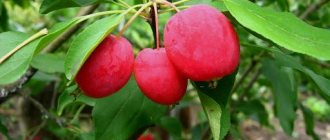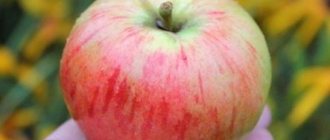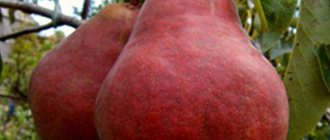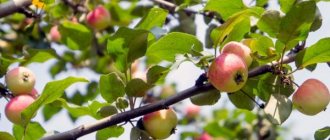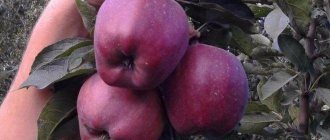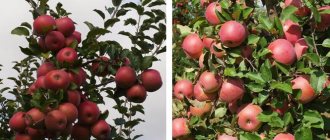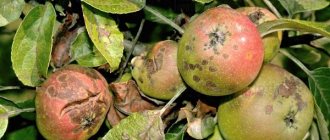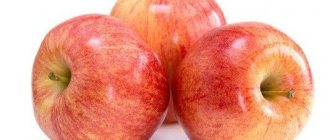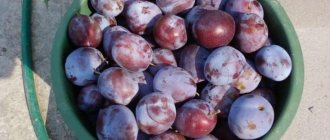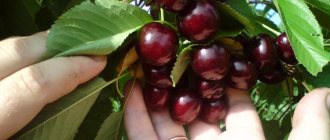Currently, there are more than 100 varieties of apple trees, which have different tastes, fruit sizes, and a certain set of both advantages and disadvantages. The history of selection of this crop began in 1964, when an unusual branch with a large number of leaves and a huge number of apples was discovered in Canada on the McIntosh apple tree variety. By grafting this branch onto the rootstock, we obtained the Vozhak apple tree variety, which retained all its properties. In this article we will consider the Ostankino apple tree, which is columnar. The Ostankino apple tree is one of the first apple trees of this type to be grown in Russia. This variety showed very good results. The hybrid was bred by combining the Vozhak and Obilnoye apple tree varieties. The authorship belongs to V.V. Kichin. The Ostankino apple tree was bred in 1974 at the Institute of Horticulture. After passing a series of tests, the plant became officially registered.
Columnar apple tree Ostankino
What attracts about columnar apple trees :
- Compact , the crown is about a meter in diameter on an adult tree.
- Beauty . You need to see them: lined up along the path or near the wall of the house.
- Precociousness . They produce a harvest the next year (or even in the year of planting). It doesn't matter that it's 5-10 apples.
- is very convenient to care for them due to their low height.
- And they are very suitable even for the harsh conditions of Russia (North-East, Ural, Siberia).
Advantages and disadvantages
The Ostankino apple tree is productive, drought-resistant, requires moderate lighting and watering, and is not afraid of windy, open spaces. If we summarize the main advantages of the variety, we get the following list:
- Compactness.
- Productivity.
- Excellent taste.
- Exceptional frost resistance.
In addition, when choosing columnar apple tree seedlings, gardeners can count on protection from pests, productivity, early maturity, and suitability for transportation. The fruits of Ostankino are juicy, strong and tasty. And there are practically no obvious shortcomings.
The variety is cultivated without problems in the Moscow region, Samara, and Perm regions. Recommended for both chernozem and non-chernozem zones. In Ukraine, with its milder climate, it grows almost everywhere. It can even grow in the Urals and Siberia, where frosts often drop significantly below zero.
Description and photo
And Russia was among the regions where scientists took a serious approach to growing such varieties of apple trees.
The appearance of this variety is the first results in growing domestic varieties of columnar apple trees. No worse than world analogues. Below are photos and descriptions of the variety.
Columnar apple tree Ostankino.
The parents are the first columnar apple tree Vazhak and the apple variety Obilnoye. Bred under the leadership of V.V. Kichina at the Institute of Horticulture. And this was in 1974.
Notice! Just ten years after the appearance of the Vazhak variety. In science it is very efficient and fast.
About the variety - Ostankino columnar apple tree, description, photo:
- After 6 years of testing it was included in the State Register . The fruits are distributed evenly along the trunk. They start from the ground somewhere 25-30 cm. The large leaves are dark green in color and almost cover the trunk.
- Amateur gardeners in the Moscow region like it more . Many residents of the Non-Black Earth Region and the Center of Russia look at it and dream of having it on their plot near their house.
- Autumn variety . Some call it early winter.
- The crown is typical for a columnar apple tree. Rings and spears are densely placed throughout the trunk. They are able to bear fruit for up to 14 years .
- Branches and shoots are strong and elastic. Can withstand strong winds. The fruits are distributed evenly along the trunk. They start from the ground somewhere 25-30 cm.
The fruits are distributed evenly along the trunk.
- Large dark green leaves with medium-length petioles.
- Round and slightly flattened fruits on short stalks. Most are the same average size.
- The weight can be in the range of 130-150 g. There are also more than 200 g. They even collected 300 g.
- The apples are an attractive color - on a greenish-yellow background, a red-violet blush covers more than half of the surface. You will also find completely covered apples.
- Dessert taste of juicy pulp with a predominance of sweetness. But there is also sourness.
Advice from experienced gardeners
Gardeners advise choosing varieties taking into account your frost resistance zone. Columnar apple trees are not too strong to retain the possibility of bearing fruit if their fruit buds are killed by frost in winter.
It is also important to consider that:
- The tree needs foliage for photosynthesis. You should not experiment with removing it. After all, to produce 1 apple, a tree uses the energy of 50 leaves.
- For southern regions with hot summers and warm winters, it must be taken into account that the tree needs 1200 hours of frost in order for it to enter a new growing season. Therefore, in regions with above-zero temperatures in winter, the apple tree will be very uncomfortable.
- The size of the tree can be controlled. Just pinch off the central shoot. Use only sterile instruments during work.
- Some varieties of columnar apple trees require a pollinator tree. Check this question with the seller if you buy any other variety besides Ostankino.
- Small trees can also be grown in containers. For such an apple tree, it must be at least 50 cm in depth and in diameter.
- In order to decorate the area, columnar trees are often planted surrounded by ground cover plants. This saves you from having to loosen the soil and remove weeds.
additional characteristics
Advantages and disadvantages
The Ostankino variety is a bright representative of domestic columnar apple trees that can grow in our difficult conditions:
- High precociousness. Already in the second year you will be able to try several apples not only for taste. But also make sure that you were not deceived with the variety. Agree with me, this is important!
- Good yield . From 5-6 years old, 7-9 kg annually.
- The fruits are in good demand due to their taste and appearance . Its size and weight allow it to be noticeable not only among columnar apples.
- Experts note good disease resistance . To compare with ordinary varieties, let's say this. At the level of the best.
- Very convenient for planting and growing in your garden. Due to its small size.
- And what kind of look do they create? So, count their decorative properties as a plus.
Flaws:
- You can come across serious complaints about their high cost .
- And the need to replace these trees with new ones in fifteen years.
Advice! If someone found the money to plant a garden of dwarf or semi-dwarf apple trees on one hectare, he will also find money for 20 thousand columnar ones. And in 10-12 years of a productive garden, you can earn money to plant a garden on more than one hectare!
Dimensions of an adult tree
Lovers of short trees will not have to worry about the problems of collecting and caring for an apple tree. Even a stool is not needed for short people.
After all, trees of this variety are semi-dwarf by nature:
- It can reach a height of 2 meters, or maybe a little more.
- The height of an annual seedling is no more than one meter.
Annual growth
You can calculate it yourself: on average 6-9 cm . How will you care for it (water and feed).
Productivity
15-16 kg of delicious apples from one such tree. This is a high yield for columnar varieties.
High-quality care makes it possible to double the yield . Important for farmers.
On an area of one hectare, when 20 thousand trees are planted (this is the norm), the yield of this variety is about 800 centners.
Important! If you provide an improved agricultural background, there will be more than 1200 c.
Tasting assessment
It is perhaps difficult to find an apple lover who does not know the summer apple variety Melba. And I definitely with pleasure . Ostankino apples are very similar in taste.
Delicious and beautiful fruits of the Ostankino variety.
Winter hardiness
The columnar apple tree variety Ostankino was bred in the Moscow region. And for cultivation in the central regions of Russia.
And yet, its winter hardiness is not as high as the varieties of columnar apple trees bred in recent years.
Disease resistance
To scab is very high, as well as to other diseases. There are opinions that there is no need to treat diseases at all.
But something else prevails - 2 preventative treatments will not harm their taste.
Reviews
Next, you will find out what impression the Ostankino apple tree created from the reviews of gardeners:
Sergey Karasev: For me, a columnar apple tree is both a godsend and a salvation. The small area does not allow planting even 5-6 apple trees on a dwarf rootstock. But I wanted some apples. I was attracted by the variety and versatility. I don't understand those people who only give Jonathan or Golden Delicious. And the Ostankino apple tree at that time was among the few offers on the market (which was not as deceiving as it is now).
Stepan Pronin: I want to talk about columnar apple trees. Which grow in my garden: President, Vasyugan, Malyukha and 8 more apple trees. I won’t single out any one in particular. I’ll tell you about Ostankino (it’s often discussed online). I was surprised by the size of the apples. Their taste and ability to be preserved right up until December. I didn't even think that she was capable of this.
The Ostankino apple tree surprises with the size of its apples.
Igor Solntsev: They talk about the very high price of columnar apple trees. And that they are not as tasty as our traditional Antonovkas, Anises, Aports, and White fillings. Here is the Ostankino variety. It is possible to plant them in a small area (it is very convenient to care for them) and grow them in our conditions (northern Moscow region). Beautiful and tasty apples.
Strengths and weaknesses of the variety
Experts actively use Ostankino as a complex donor in the selection of columnar forms of apple trees, highlighting primarily the compactness of the crown, high yield, and resistance to fungal diseases. In addition, experienced gardeners note other valuable qualities of the variety:
- winter hardiness (at the Melba level);
- decorativeness of the plant;
- taste and marketability of fruits;
- keeping quality and transportability.
In the conditions of the Moscow region, the apple tree is resistant to winter frosts down to −35 ℃. To prevent the roots located close to the surface from being damaged, in the fall it is recommended to leave the foliage in the circle around the trunk and wrap the lower part of the trunk with protective materials, including from rodents.
The standard planting density of columnar apple trees in commercial orchards is 20 thousand trees per 1 hectare of area
The disadvantages of the variety include:
- high cost of seedlings;
- short period of fruiting (up to 15-16 years);
- the need, almost every year, when the apical bud of a column dies, to select one of 3-4 apical shoots and leave it as the central one for continued growth;
- defeat by powdery mildew (2.0 points out of 4).
Features of planting and care
Deadlines
Like most gardeners, who may even see an apple tree blooming in just a month. True, single flowers, not numerous.
Suitable for planting in autumn - late September-October.
Attention! Plant seedlings after the leaves fall. But 15-20 days before the onset of frost.
Technology
In the process of planting apple trees there are, as it were, two small extremes :
- Some consider this a very difficult process. And planting for them is like observing a certain ritual.
- Others consider it business as usual. Even very simple. I bought it, brought it, dug it up, planted it.
Ostankino variety seedling.
I would advise choosing something in between. And circumstances can make adjustments to this process.
But you must follow the basic rules:
- Choose a place to plant . Open areas and places accessible to the sun are suitable. Some experts even recommend lowlands where there is more snow. But high groundwater is not suitable.
- Select a seedling : I would recommend, like many gardeners, organizations with an established good reputation and trust (specialty stores, nurseries, friends). Don't be tempted to buy at fairs . I have personal experience of being deceived. And repeatedly.
- Buy one-year-old seedlings and check their condition and quality. Without damage. Even annual ones look respectable. Do not allow the root system to dry out (bags, bags with soil and wet sawdust). Many reputable nurseries offer seedlings with a closed root system.
- You select its dimensions depending on the root system of the seedling. They should be placed freely, without bends. Better to dig a little more. I don't even indicate the sizes.
- Form a mound and carefully spread out the roots.
Distance
By purchasing seedlings of this variety, you yourself determine their place on the site. Considering the peculiarity of the Ostankino variety . After all, he is a half-dwarf.
And if you plant by area:
- Between rows 90-110 cm,
- Between trees – 40-60 cm.
Advice! And you will need up to 200 seedlings for this hundred square meters.
Planting density of a columnar apple tree.
Agricultural technology
This is a set of activities and your actions to care for her.
To obtain high and constant yields of good apples:
- Water your apple trees regularly . Like any columnar - about 2 times a week. Especially in the first year after planting. If you provide drip irrigation, the yield will be better.
- Feed systematically . While this procedure is desirable with a regular apple tree, it is mandatory with a columnar apple tree. The root system requires. Options: In spring - manure (rotted).
- Urea – 50-90 grams for wood. Or maybe foliar.
- Potassium-phosphorus (up to 100 grams) in summer.
- Peat, compost, sawdust, grass, hay.
Pruning and crown formation
They have their own characteristics. There is only one task - to maintain columnarity .
Carry out before sap flow begins in spring:
- Trim dry and damaged branches.
- Cut good shoots into 2 buds.
- Next year, leave the vertical shoot, and cut the horizontal shoot back to 2 buds.
- Next season, cut off the fruiting shoot. The rest are for 2 kidneys.
Attention!
- Watch the apical bud. If it is damaged, 3-4 vertical shoots may grow. Leave one stronger. Cut out the rest. And this happens every year.
- If you leave all the shoots, you will get the original crown - wine glass-like. And with greater productivity. I was convinced personally on my columnar apple trees. If you have space, it’s even a win.
Pollinator varieties
A unique variety thanks to the Obilnoe variety. It blooms and forms an ovary even in poor conditions for bees.
Diseases and pests
The main pest of any apple tree is the codling moth. The codling moth butterfly lays eggs in the ovary. The hatched larvae will live in the growing fruit. One caterpillar is able to damage not only the apple in which it is located, but also crawl into another.
Over the summer, up to 3 generations of this pest appear, each of which will lay eggs. Spraying against codling moths is carried out immediately after the apple tree has finished blooming. These can be the drugs “Mitak” (20 g), “Biorin” (10 ml), “Intavir” (1 tablet). Dilute any substance in 10 liters of water and spray on a windless day. You will need about 3 of them with an interval of 40 days between them.
Since trees cannot be completely protected from contact with insects, farmers also use:
- attracting birds to the garden by hanging feeders;
- hanging traps with pheromones - the norm is 1 trap per 100 apples.
Did you know? Other insect predators are often involved in the fight against insects. So 1 ladybug can destroy up to 5000 aphids in its life. To attract ladybugs to your garden, plant fragrant plants, such as mustard, between the rows.
If pests are detected, the tree is sprayed with one of the insecticides for complex use. This allows not only to destroy detected insects, but also to create a barrier to attacks in the near future. Columnar apple trees are resistant to fungal diseases. Therefore, if you water them correctly and water does not stagnate at the roots, then there will be no problems with diseases.
Features of ripening and fruiting
What year does it bear fruit after planting?
When planting an annual seedling in the spring, you can try apples in the fall. Variety experts advise taking your time and removing the flowers. For the benefit of the apple tree. Yes, for your benefit.
Deadlines
Blooms
It blooms in the usual time for autumn varieties - the second half of May .
The unusual thing is different. An ovary forms on all flowers. And it needs to be thinned out. To eat bigger apples .
Fruit ripening
Ripen at the end of September. The extensive geography of its cultivation also affects the timing of ripening.
The fruits ripen at the end of September.
Harvest and storage
Ostankino will begin bearing fruit in the second year after planting. Some gardeners remove the ovary of the second year in order to allow the tree to gain strength for further growth and development. Over the next few years, yields will increase. But it will not necessarily remain stable. Therefore, you can collect either 10 kg of fruit from one tree or 2 times more.
Apples ripen in September. The main criterion for ripeness is the change in color. Apples at the stage of technical maturity are green. As they ripen they turn red. The intensity of the red color depends on the amount of sun the particular fruit receives.
The fruits are collected in dry, sunny weather. The collected apples are sorted. Deformed, damaged, damaged items are set aside for processing or consumption in the near future. Only undamaged fruits are selected for storage.
They are placed in boxes or boxes. Apples can be stored for 4-5 months. They have excellent keeping quality. Boxes with fruits are placed in a room with an air temperature of about 0°C and a humidity of 70–80%.
Read more about how long to keep apples fresh for the winter at home.
Features of fruiting
Shelf life of fruits
Those who grow and collect these apples have the opportunity to eat them fresh even on New Year’s Eve. By ensuring proper storage conditions. Under normal conditions – only a month and a half.
Features of growing in the Moscow region
For the Ostankino variety, the Moscow region is home. And not only this region. Gardeners in North-West Russia also know the advantages of this variety. They sit you down. Its apples are grown and enjoyed, of course, it all depends on how planting and care are carried out.
Description of the Ostankino variety
The Ostankino variety is known as one of the first columnar semi-dwarf fruit trees .
In adulthood, the Ostankino variety apple tree
reaches 2 meters , the trunk is shaped like a column, and as it matures it is abundantly overgrown with fruit-bearing sprouts.
It has an unusually tough and hard tree species that does not deform at the time of fruiting under the weight of the crop, even when it bears a large number of fruits. Has large elongated leaves. The foliage is dark green, the surface is shiny, the edges are crenate.
Despite their semi-dwarf appearance, Ostankino fruits are medium to large in size. The approximate weight of an apple is 150 g, but there are heavier specimens. With a smooth greenish-yellow surface, the fruit has a rich dessert sweet and sour taste and a bright aroma. It is noteworthy that the external color of the fruit has a purple-blue blush .
Watering and fertilizing
Since the roots of this apple tree are shallow, they are not able to obtain moisture in the required quantities. Therefore, it is recommended to use drip irrigation. If the weather outside is dry, then the tree needs to be watered at least twice a week.
The high location of the root system is also the reason that the apple tree needs to be constantly fed. As soon as the foliage blooms, it is necessary to apply special fertilizing every 14 days. It is necessary to feed the tree before the end of the fruiting period. Here are the substances that can be used as fertilizer:
- mullein diluted 1 to 10;
- chicken droppings – 1 to 20;
- nettle infusion (nettle is filled with water and placed in a sunny place, after fermentation it is diluted with water 1 to 5);
- horse dung;
- special extract for feeding apple trees;
- urea.
It will be very good if you use more than one type of fertilizer. It is necessary to alternate them. Urea is best suited for foliar spraying. During cloudy weather, it is recommended to perform foliar feeding, as this will help activate the absorption capacity of the root system. In late autumn, when the crop has already been harvested, the tree trunk circle should be sprinkled with a mixture of superphosphate and ash. Superphosphate – 2 tbsp. l, ash - 1 cup.
Landing specifics
This variety of apple trees does not require much space between the trees during planting, since its crown does not grow. Ostankino is adapted to growth not only in soil. It can be grown in containers or very large pots. Seedlings suitable for planting:
- height up to 75 centimeters;
- with a straight barrel;
- from 1 year of age;
- without leaves and side branches;
- without damage, deformation, rot and fungus;
- with bright and fresh bark;
- with developed fibrous roots;
- with a clean and healthy root collar;
- 2 summer seedlings with 3-5 branches extending from the trunk.
Timing and schemes for placement of seedlings
It is recommended to plant apple trees in the spring in early or mid-April. When planting in the fall, you should choose the time from August 25 to October 10.
For seedlings you need to choose a windless place. Strong air currents can cause the apple tree to break. Trees should be planted at a distance of no more than 30 meters and no less than 40 centimeters from each other.
Technology for planting young apple trees
To plant an apple tree in the spring, it is worth preparing the place in the fall. To do this you need:
- Dig a hole with a diameter larger than the roots of the seedling. The size of the recess is about 40 centimeters wide and 50 centimeters deep.
- At the bottom of the pit, drainage made of crushed stone or expanded clay should be placed in a layer of up to 20 centimeters.
- The soil obtained during excavation must be mixed with humus. You need to add superphosphate and potassium fertilizers in an amount of 90 grams to this mixture.
- Place the entire mixture on the drainage.
- Before planting, soak the roots of the tree in water for 2-3 hours.
- Place the seedling in the center of the hole and cover it with soil starting from the edges.
- Make sure that the root collar is at ground level and the grafting is 6-9 centimeters higher.
- compact the soil a little and make a hole near the tree trunk;
- water the tree with 2 buckets of water.
See also
Planting and caring for Japanese quince in open ground, cultivation and propagation
Read
How and when to plant
Planting of seedlings should be done in autumn or spring. If you choose the autumn period, it is best to do this before October. And in the spring, planting is done in March. A distance of 40 cm should be maintained between seedlings. Then the trees will not darken each other and their crowns will touch. Planting a fruit seedling occurs subject to the following instructions:
For planting, you need to choose a place that will be well warmed by the sun's rays. But there shouldn’t be any draft there.
Soil preparation. For young plants, it is necessary to prepare a hole for planting in advance. Its depth and width should be 50 cm. The root system of this apple tree variety is quite voluminous. So the recess must be of sufficient volume.
Now you can start fertilizing the soil. Since the trees are located quite close to each other, this greatly depletes the soil
In the first year of growth, it is important for seedlings to absorb the necessary nutritional components. To do this, you need to place fertilizer in the planting hole.
Dolomite flour is used to reduce soil acidity. It is not necessary to apply mineral fertilizers in high concentrations. The roots of the seedling are still quite weak, so they will not be able to absorb many nutrients.
Now is the time to start preparing the young plant. Its trunk should not contain leaves. Place the roots in water before planting. Keep them there for several hours. You can also perform partial pruning of secondary roots.
Remove some of the soil from the hole and place a seedling there. Gently straighten the roots and then cover with soil and compost.
Next, the seedling needs to be fully cared for. Drive a peg near the trunk. Tie the trunk and branches to it. This will be an excellent protection from the wind. While still a young plant, it requires moisture. Watering should be plentiful. One tree will require at least 20 liters of water. Loosen the soil to allow air and water to reach the roots. If the trees are planted on sandy soil, then you will need to take care of laying a mulch layer. Humus or peat is perfect for this.
But what the Spartan apple tree variety is, what this variety looks like, and what you should pay attention to when growing. In the video - planting a seedling:
In the video - planting a seedling:
